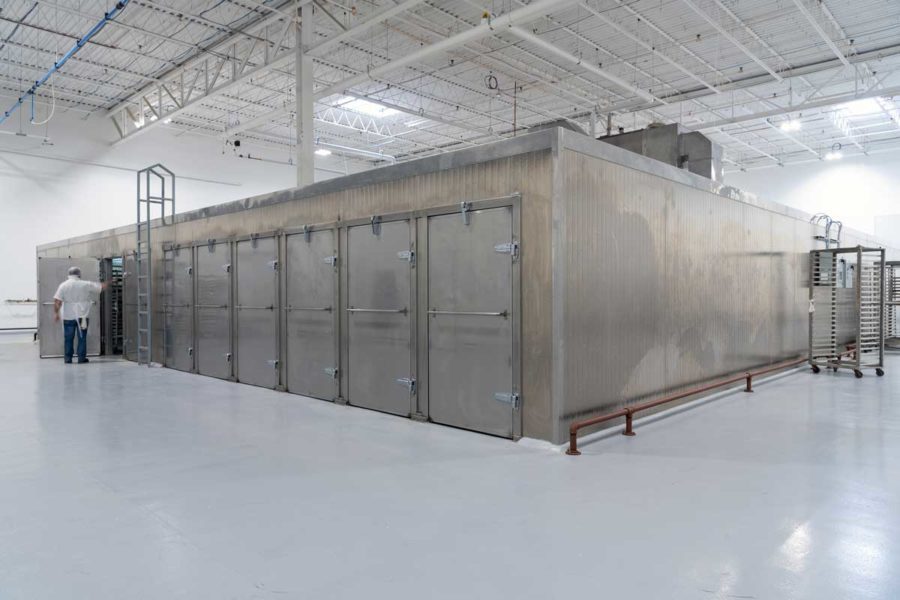|
|
Fireking Baking Co.’s previous building contained most production in one large space. The new one gives each step of the process plenty of room to breathe. Production loops throughout the building. Twenty-two loading docks line the building: half receiving ingredients and the rest loading distributors’ trucks. Ingredients are stored in either an ambient storage room or refrigerated cooler when necessary.
All ingredients are currently hand-scaled, but plans are in place for an automated system later this year. Two silos purchased from another bakery sit outside waiting for certification for automated flour scaling and delivery. Acuscale rebuilt the control panels on the silos and will be providing automated minor ingredient scaling not only for accuracy and consistency but also traceability and lot tracking. Until the silos are certified, however, Fireking is using bagged flour and manual scaling.
In the corner of the ingredient scaling room sit two kettles prepping honey for the honey wheat breads. Fireking has always cooked its own honey, but the previous space only had room for one smaller kettle.
After scaling, ingredients are moved to the mixing room where 10 twin twist mixers from Koenig bring together the doughs that will become Fireking’s artisan buns, rolls and breads. Each mixer can handle 240 kg or 529 lbs of dough. Bowls are labeled to transport each type of dough to the appropriate makeup line.
The makeup room houses seven production lines, set up neatly side by side in the large bright room. There are two Koenig industrial roll lines, one Koenig industrial roll line with stamping capabilities, one Koenig Menes stress-free line, one Koenig Rex Futura roll line with proofing and stamping, one Rheon stress-free line purchased for the move and one smaller Rheon stress-free line brought over from the old facility. Bowl lifts raise and dump the dough into the hoppers at the beginning of these production lines, which enable Fireking to make a wide range of hearth breads, pan breads, and rolls of all sizes and shapes.
On the roll lines, dough is divided and moulded to the appropriate size. It’s then placed on racks to be sent into the retarder. Among the industrial roll lines, Mr. Acerra has diversified the capabilities. The two Rex roll lines turn out up to 24,000 pieces an hour of hamburger or hot dog buns, lobster rolls, or pull-apart buns in a range of sizes.
The newest line, the Industry Rex Compact AW divider/rounder with Combiline EC roll line, was shown at last year’s International Baking Industry Expo and can create Kaiser rolls with a “soccer ball” shape or braided appearance. It also has seeding capabilities. This gives Fireking the flexibility to be creative, something
Mr. Acerra holds as a critical part of his business.
He’s gone so far as to maintain a small stress-free production line from Rheon that he has had for years to handle small batches of product for foodservice customers. The smaller capacity of this equipment, as well as its ability to handle delicate ingredients such as real cheese and fresh onions, outweighs the fact that it requires more labor to run. Being able to say yes to customers’ special requests is worth it to Mr. Acerra’s business.
“It really stimulates your imagination and your staff because they aren’t making four-by-four ciabatta every day,” he said. “Sometimes you pound your head against the wall and think, ‘Why did I do this?’ But at the end of the day, you look back, and it’s satisfying. It satisfies your need for new and different things.”
Two stress-free lines run high-hydration doughs such as ciabatta, focaccia and baguettes. On the Menes industrial sheeting line, a Twin Sat double satellite head imparts minimal stress on the dough as it’s reduced to the desired thickness. After sheeting, dough is rolled into the appropriate shape, a seeding unit tops it if necessary, and then the pieces are panned.
After makeup, pans are placed on racks manually and then moved into the retarder, which, like the freezers and proofers, were custom-built by Fireking’s team of engineers. The retarder’s Goedhart cooler introduces mist into the air to prevent the doughs from drying out and cracking. A flap system was designed to catch 90% of the moisture and prevent it from dripping onto the product.
After product retards from one hour to a full 24 hours, it moves into the proofer. When designing the new bakery, redundancy was built in. Fireking’s team of engineers built two retarders and proof boxes so the bakery can meet production demands when the busy production season hits in the summer. And in the unfortunate circumstance that a proofer or retarder breaks down, the bakery can still function.
Once dough is proofed to up to two hours, employees prep it for baking. That could mean an egg wash for buns, lye bath for pretzel buns or simple scoring. Then it’s into the oven room, which is separate from the rest of the bakery’s processes.
This article is an excerpt from the April 2020 issue of Baking & Snack. To read the entire feature on Fireking Baking Co., click here.






